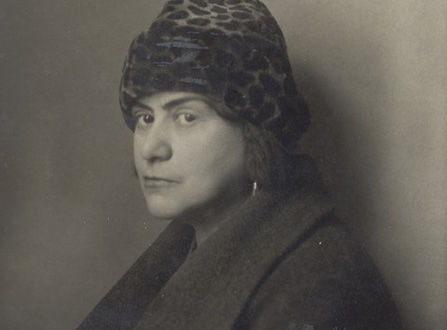Else Lasker-Schüler the Painter
Else Lasker-Schüler was a diverse and multi-disciplinary artist. Besides being a poet and author, a playwright and woman of the stage, she also produced paintings and drawings. She would illustrate the covers of her books of poetry herself and would intersperse them with her own illustrations. Not only that, but painting and drawing were also a part of her daily life. Today we have quite a few of the poet's works of art: Lithographs, charcoal, chalk and pencil drawings, as well as ink drawings in black and white and in color. Essentially, painting and drawing accompanied her whole life. She drew on paper of all sorts, whenever the opportunity presented itself – in cafes, while travelling, while waiting, often next to a text she wrote, on a piece of paper that had another use, or on the other side of a paper that had been written on.
In retrospect, looking at the entirety of Else Lasker-Schüler's work – her poetry, plays, and prose, as well as her paintings and drawings – it is clear that her world as a painter was deep and complicated. Her paintings and drawings bear clear characteristics which reflect aspects of the soul of this diverse artist who crossed borders in her life and works.
The figures in the paintings are always looking toward the left. Many of them are in motion. The figures are elongated and childish, and often it is hard to identify their gender. They are characterized by an androgynous quality. Their facial features almost always repeat themselves: slightly slanted eyes, a sharp nose, their gaze cast forward and down. They seem quiet, wrapped up in themselves, certainly when they are alone, but also when they are in a group. Often, the figure of Yusuf, "the Prince of Thebes", appears. He was a character that Else Lasker-Schüler created as an alter-ego, and who existed in her real life. Broadly, from a cultural-historical perspective, and in the eyes of the great fate that ruled her stormy and confused life, Yusuf was Else Lasker-Schüler.
The silent figure reflected in the paintings touches the heart. The perspective catches him exactly where his eyes can't be seen and the viewer remains with the sense that his eyelids are half-closed. Without a doubt, we find here reflections of the poet's inner world; she feels dismissed, exiled and forced to wander. At the same time, that silent look may also be an expression of timelessness, and reveal the sources of the character in Else Lasker-Schüler's world: Ancient Egypt, Commedia dell'arte, the world of theatre (and maybe even puppetry) as well as evidence of the growing questioning spirit that was expressed in her written work until the end of her life. Ancient Egypt is present in the paintings in her general preference for two-dimensional figures, seen from the side, as well as her choice of primary colors – red, blue and yellow, just as in the ancient murals and papyruses of the Egyptians.
On the one hand, the abundance of small drawings on the margins of texts and in letters, on napkins and random pieces of paper, can give the viewer the mistaken impression that this was an unimportant casual hobby in relation to the literary activity of the great poet. On the other hand, a broader view of her graphic works and paintings reveal that Else Lasker-Schüler was indeed a painter in the full meaning of the word. Proof of this is that, today, almost 70 years after her death, her paintings are very sought-after by collectors.



